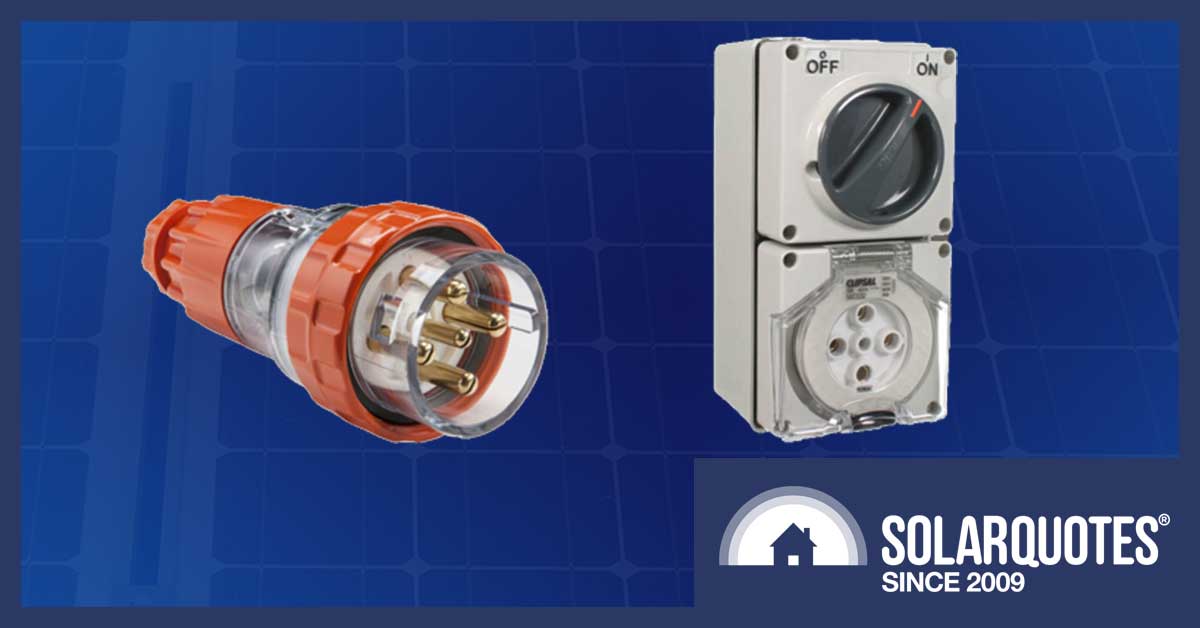
Standard Australian socket and plug for 32 amps 400 volts 3 phase power.
TL;DR: Hell, yes.
In Australia, the wall socket pictured above is your go-to option for a 3-phase electricity supply, while this one is for single-phase:
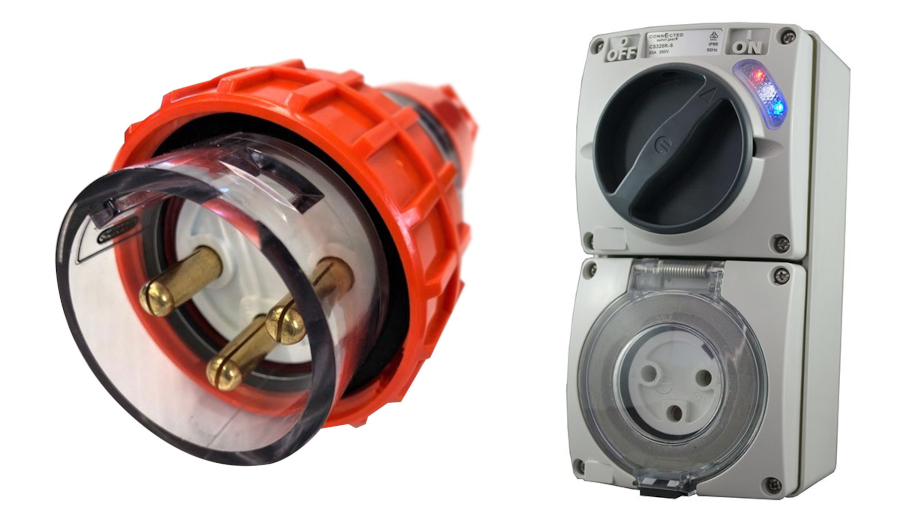
An industrial-duty 32A single-phase plug and socket outlet, suitable for the Tesla outfit pictured below. These might become popular in Queensland.
I see a future where everywhere you park, there will be at least a modest-sized socket to charge an EV. Maybe you don’t plan on an electric vehicle yet, but if you’re building a house or garage, you’d be mad not to run a cable to the garage – and a socket outlet is a handy way to terminate that supply.
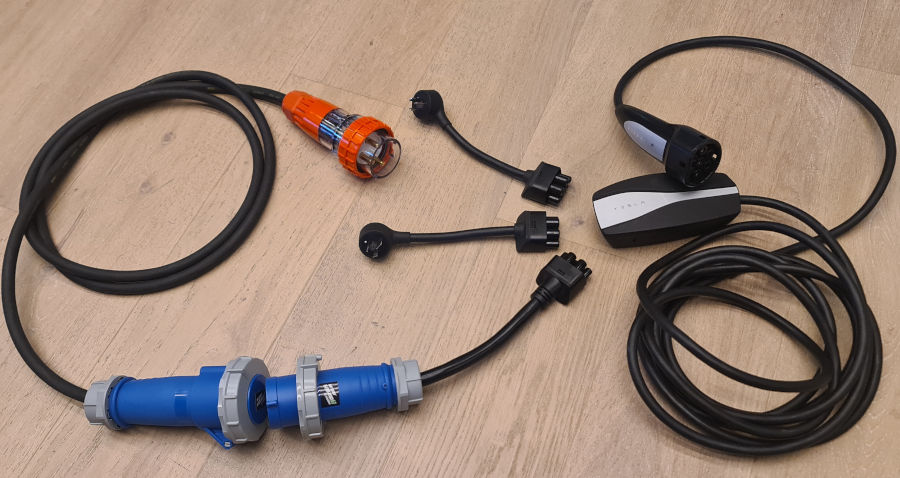
A Tesla brick EVSE on the right, with three adaptor tails offering 10A, 15A and 32A via a third-party kit. The blue CEE socket is further adapted to a standard Australian 32A plug in orange. This orange plug can be swapped for 20A, single-phase, 20A 3-phase and 32A three-phase plugs depending on the outlet. Handy when travelling in the country where industrial sockets are much more common than EV charge stations1.
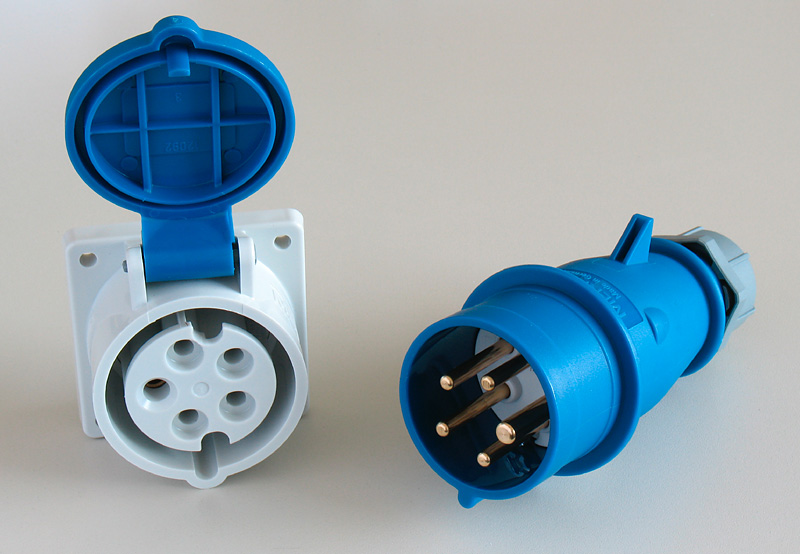
CEE-Stecker und Buchse 3P+N+PE 9h for 110/230V – credit Wikipedia
Some EV Chargers Need A Socket
If you buy a Fronius Wattpilot Go, then it comes with a plug. This means you can have a socket installed at home, at your work, at your holiday house and not have to spend $1000+ per premises screwing electric vehicle supply equipment (EVSE) to the wall. I know some electricians actually prefer to install an EV charger this way. It saves on emergency call-outs if the end-user can remove a faulty unit to get it repaired.
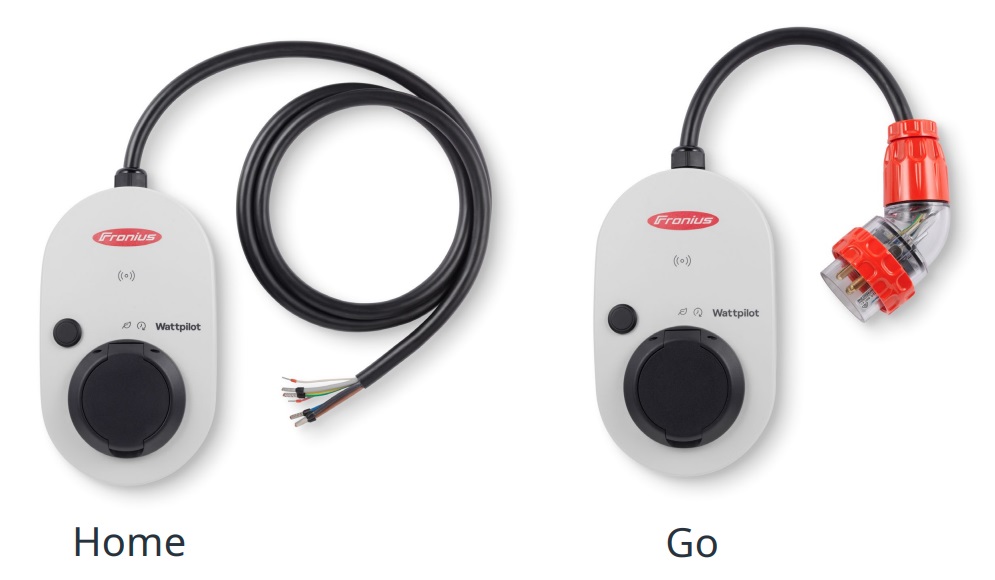
The Fronius Wattpilot home versions are hardwired in, while the Go version gets to go. The large dark circle is a plug cover, while the small dark circle is a button that allows you to adjust the charge rate.
Skirting The Rules
Queenslanders may be aware by now they can’t have a full 7kW/32A EV charger on a single-phase supply, unless it’s hard-wired to an off-peak tariff. We’ve written about this rule and the ludicrous situation of paying coal prices for your own sunshine, but if you want an anytime EV charger, 4.6kW/20A is all Energy Queensland want you to have.
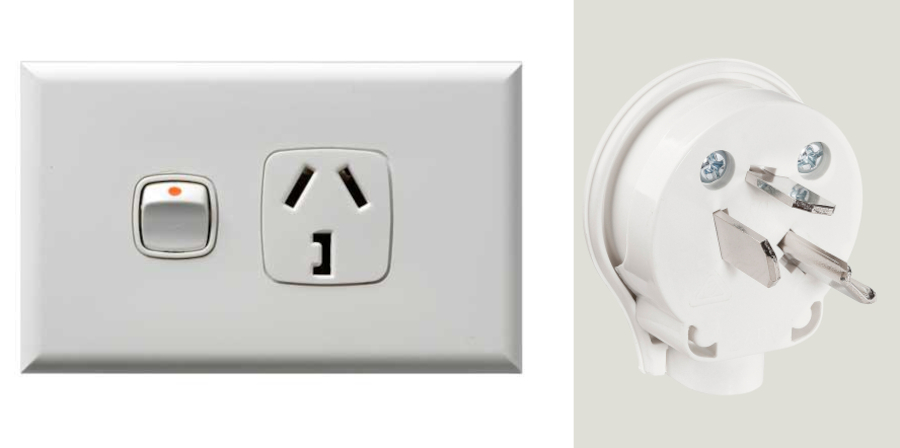
The less obtrusive 32A single-phase outlet. I would still opt for a round pin industrial type at the top though.
Many have claimed there’s no rule against installing a 32A socket outlet in a Queenslander’s garage. If the end user plugs an EV into it, well, that’s on them, even if they might technically be breaking some service rules stating you shouldn’t switch on a 20A load without first getting network permission.
Electrically, It Doesn’t Need An Isolating Switch
Many electricians install an isolator when they install a permanent EVSE. They do it on general principle, and it’s handy for several reasons. It means changing the EVSE over for service or replacement is much easier, and it can offer a simple way to lock out unauthorised users. However, AS3000 says an EV charger is technically a socket outlet (not a hard-wired appliance), so an isolator isn’t required.
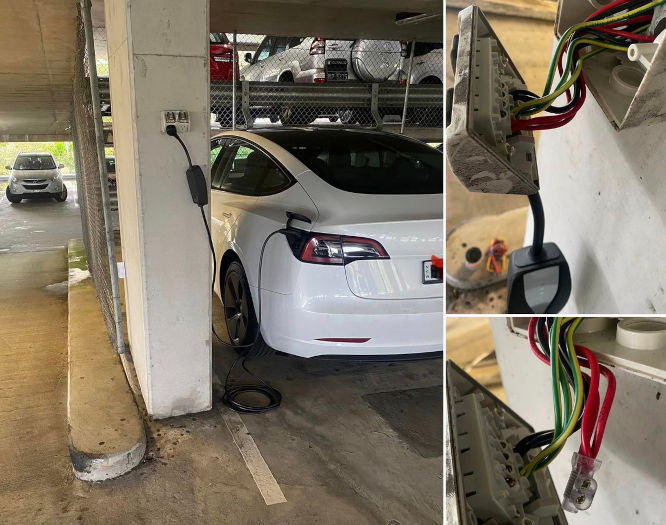
Speaking of isolators. Petty car park operators are paying electricians $150/hr to isolate power points that cost a measly couple of kilowatts to run.
Culturally, We Do Need A Switch
Pulling up and plugging in has to be the new norm as we soak up cheap daytime electricity.
Early adopters of EVs have for years listed private homes with EV charging, partly from necessity because public charging was so sparse but also because having a local you could trade EV tales with while your car topped up was a good community builder.
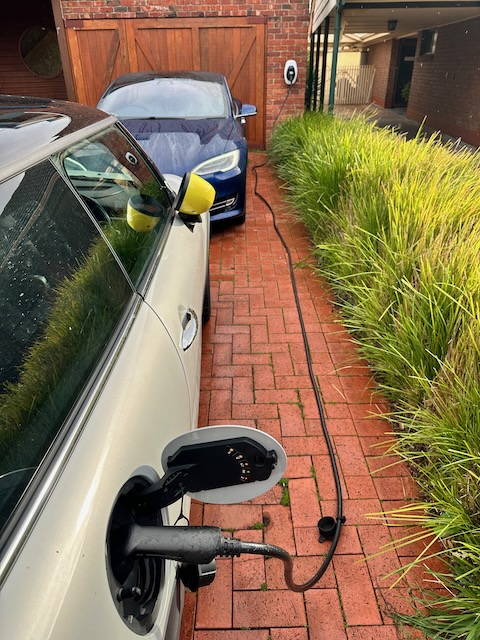
Drinks in the fridge and a 10m lead in the driveway, ready for visitors.
Will Standard, 10A Power Points Suffice?
Personally, my EV and plug-in hybrid have modest batteries and I get away with standard 10A power points at my place. Moving forward, full EVs in Australia will mostly use CCS plugs and charge at 32A, 7kW on single-phase and 11-16kW on three-phase. This allows you to fill a modern EV overnight from empty and, more importantly, top-up quickly during the limited times that solar power or super-off-peak electricity is available.
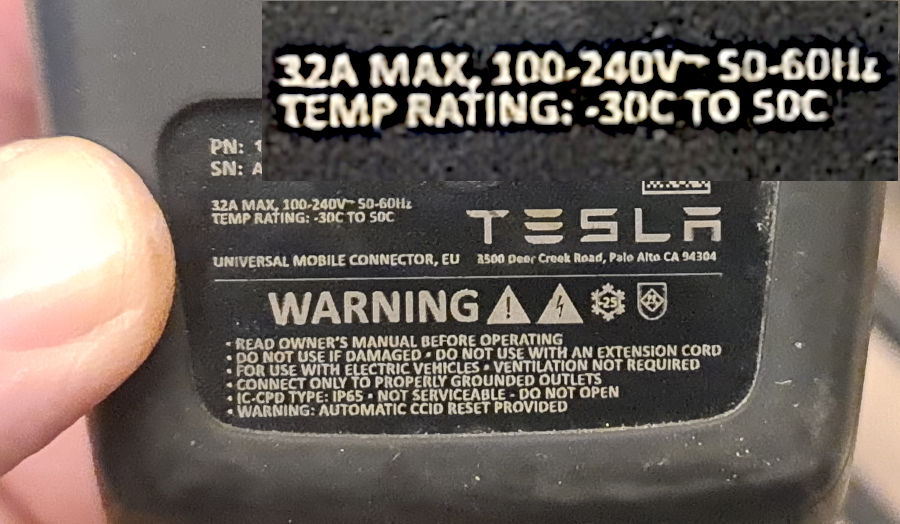
Why do phone/computer/car chargers have impossibly small print? At 32A, the $550 Tesla mobile connector is just as capable as the $750 Tesla Wall Connector on a single-phase supply.
How Good Is The Internet?
While researching this article, I came across these two beauties I had to share. A recessed wall charger:
And even better, an IP67-rated solid aluminium retractable power outlet that drops flush into the ground:
Footnotes
- Although real Aussie adventurers should buy a proper 3-phase mobile charger ↩

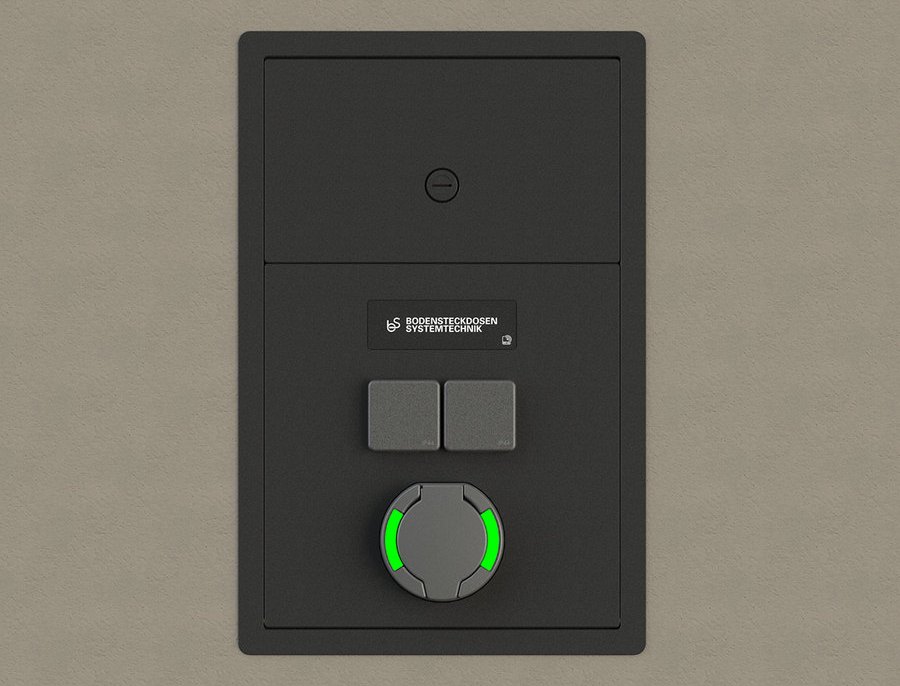
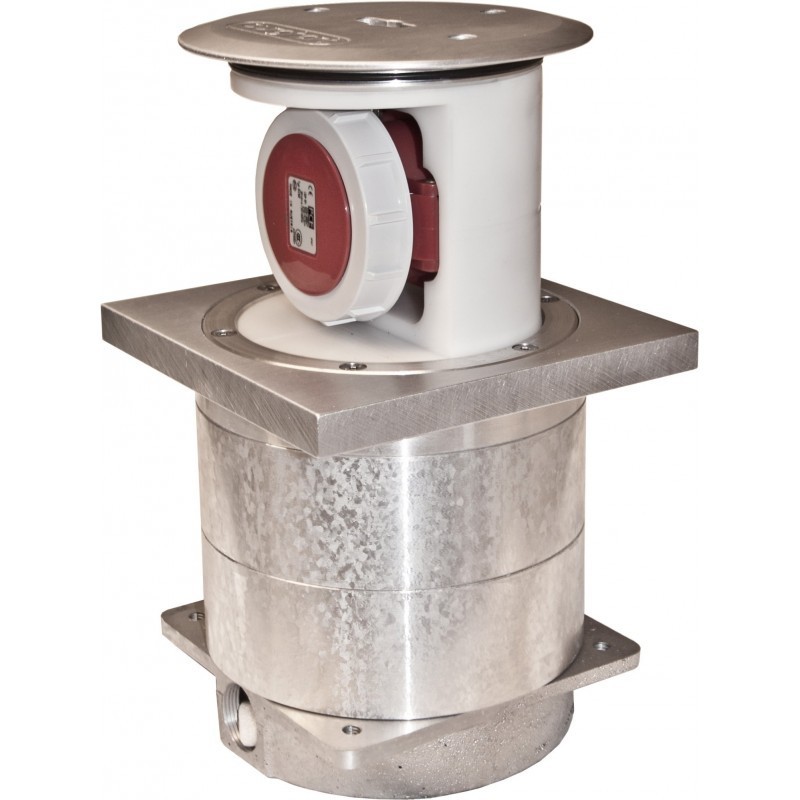
 RSS - Posts
RSS - Posts



I have a Tesla wall connector for my Model 3….. because in 2019 it came with the car.
It’s wired to single phase, 32A, (which is all we have). It’s a massive and very expensive job to upgrade the house (which has underground power) to 3 phase, so that simply won’t be happening.
However, you’d be crazy to build a new house without 3 phase and without suitable wiring run to the garage, even if it’s just terminated in a junction box for the time being.
Q. Would I bother buying a dedicated wall connector if I bought a Tesla today?
A. Likely not, unless the house had 3 phase, as the 32A tail with the mobile UMC charger works fine, thus supplying up to 7kW, which is ample for most people.
I don’t believe that three phase power is worth it because of the higher daily charge for the power supply and as it does not charge a lot faster, 11 kW as opposed to 7.4 kW. The future for those with pv is DC to DC charging (panels to car).
Hi John,
Some cars will charge at 22kW and not all jurisdictions charge more for access to 3ph. If we go to demand charges for domestic supply (and the rules already allow that) then a “skinny pipe” pricing model means lower current across three phases should be cheaper, unless they charge for kilowatts demand and ignore phases. In any case 3ph offers better balance an less voltage rise to hurt solar PV production.
So far I think only SolarEdge offer DC – DC topology.
Which retailers in what supply areas charger a higher daily supply charge for 3 phase? Currently building on the NSW south coast so rang a number of retailers to check and they all said the supply charge was the same as single phase.
I don’t believe any distributors in the NEM charge more for three phase.
Hi Anthony, I am having a electric HWS fitted soon to use excess solar. When the electrician is here you suggest that it may be a good idea to have him fit a 32A 7Kw single phase socket outlet while he is here, for EV down the track. Is this just as good as having a dedicated charger fitted?
Hi John,
It’s not a bad idea at all. Make sure you give them a heads up because there’s likely to be a calculation needed to work out voltage drop. Not everyone carries a roll of 6 or 10mm² cable in the van.
https://www.solarquotes.com.au/blog/solar-voltage-rise-drop/
https://www.solarquotes.com.au/blog/solar-switchboard-upgrade-guide/
https://support.solarquotes.com.au/hc/en-us/articles/6459857973775-Retrofit-consumption-monitoring-does-a-smart-meter-really-cost-750-
No matter if you install a 3 phase or single phase, always use the 5pin socket and plug. Then you only need purchase the one plug for the EVSE no matter where you travel. More 5pin sockets out in the regions.
Is it legal (complies with wiring rules) to fit a 3 phase 32A 5 pin dedicated socket to a single phase supply?
If compliant seems this would be the more widely available socket type when travelling.
I’m not a licenced sparky, however I have seen and used several single phase 5pin plugs over the last 12 months of ownership of a Tesla. None of the Sparkies within the various groups I subscribe to have poured cold water on the idea and I’m not the 1st person to recommend this approach.
My biggest beef is people using a 10 or 15amp plug to charge their car “daily” with a UMC. I understand they only have a single-phase supply but won’t spend the extra money to have such a high load item placed on its own circuit and breaker in their home. Then they use an extension lead and wonder why the house burnt down.
There needs to be leadership by the government (DOH) to mandate a standard for such plugs and charging large loads as the population transitions to EV’s most are oblivious to understanding how electricity works. simple things like resistance = Heat. How old 10amp GPO’s can fail and cause issues. The biggest impediment to this is rental properties.
Hi Robert,
I agree we need to educate the general public about energy use & basic physics of how much you’re sucking out of the wall for an EV. However it’s as much about having things up to snuff. We have the great advantage (and it must be encouraged to soak up cheap daytime power) of being able to plug an EV in for a decent trickle anywhere, unlike the peasants with 110v elsewhere in the world.
https://www.solarquotes.com.au/blog/ev-charging-power-outlet/
My Perth WA home garage has a 3 phase 32A 5 pin outlet connected to our single phase supply. The Tesla HPWC that came with my 2020 model 3 SR+ has been fitted with a 3 phase 32amp 5 pin plug. We carry the HPWC with us on long trips which in WA often means lots of AC charging, plugging into the common 3 phase 32amp 5 pin outlets found at workshops, garages, sports grounds etc..We draw 7kW on single phase and 11kW on 3 phase. All electrical work done by licensed electricians.
Yes it’s the way to go. Way more 5 pin socket outlets out there than 3 pin. For single phase you just wire up line 1 only on the 5 pin.
“some service rules stating you shouldn’t switch on a 20A load without first getting network permission.“
Some Poms of a certain age may remember a BBC science / technology programme called (laughably) “Tomorrows World”.
They showed an invention that got around the Orthodox Jewish (& hard line “Wee Free” presbyterians) Torah / Old Testament restrictions of lighting fires or doing work on the sabbath* (different days natch).
This was a device that polled an electrical circuit every couple of seconds to see if it was open or closed and then it triggered a secondary circuit breaker to close and turn the electric light on without your devout self having done it.
Maybe a legitimate way to avoid switching on heavy loads without “Network’s” permission. You didn’t do it: “I only switched on a completely different circuit that hasn’t got anything to do with this EV, honest your honour.”
* Isle of Lewis, Outer Hebrides, late 1970’s. Not wanting to be seen with smoke coming out of your chimney to avoid upsetting the locals. Sundays were cold!
A nice informative article! You will need whatever plug/socket that is compatible with your EV, providing it meets local regulations and that your electrical installation can sustain the power required. It’s up to your electrician to advise, so don’t go spending all your money on your new EV.
Make sure that if you’re salary sacrificing/leasing a new car, that the charger installation is included.
hell no
EV are more damaging to the planet than petrol vehicles, they produce more toxins and they are not even 1% green as that is being pushed they are green is a criminal fraud
EV’s are dangerous and they can go thermal runaway inside your own garage it is literally not worth the risk – the extent of their danger can be they are just parked in your garage and they blow up due to the battery itself being the catalyst and to place yourself or anyone else lives at risk defines you are criminal
the shop in denmark that caught fire recently was incapable of being put out, they were brand new EV’s so they were not used or anything and they are a ticking time bomb
Hi Mark,
We have an FAQ you might find interesting.
https://support.solarquotes.com.au/hc/en-us/articles/6041404837135-I-Want-To-Charge-An-EV-In-My-Garage-Can-It-Catch-Fire-
Cheers
Why did I hear Caspar Jonquil saying that in my head while reading what Mark wrote?
😂
Fires at US Service or Gasoline Stations
During the five-year period of 2014 through 2018, local fire departments responded to an estimated average of 4,150 fires in or on service or gas station properties per year. These fires caused an annual average of three civilian deaths, 43 civilian fire injuries, and $30.0 million in direct property damage. Figure 1 shows that more than half of the fires (56 percent) were vehicle fires. More detail will be provided about each type of fire.
Figure
Oh dear. Is Mark serious?
If so, I can recommend a good therapist.
Given all the news stories about battery fires, almost certainly serious. I’ve heard, but not confirmed for myself, the (Australian?) firefighters are no longer responding to fires unless they first kit up with full breathing apparatus. Something about 2 whiffs of toxic fumes and you’re unconscious, with death occurring shortly after.
Hi George,
I think any modern firefighter would be a lunatic if they didn’t use breathing apparatus. EVs get a lot of flak from the regressives because they can become a self sustaining fire generating their own oxygen but to be honest any modern car full of plastic, rubber & refrigerant gas is likely to be a toxic disaster, just like a modern house fire is far more dangerous than one in a 1940’s dwelling with largely natural building materials.
https://support.solarquotes.com.au/hc/en-us/articles/6041404837135-I-Want-To-Charge-An-EV-In-My-Garage-Can-It-Catch-Fire-
Hi George, it has been standard response to wear breathing apparatus for decades. If I recal my training it was triggered or at least mentioned that potting compound in the car computer was exceptionally toxic when burnt. Speaking of Australia, do you know that there have only been 4 incidents involving six fires since 2012 in Australia? No injuries sustained in any of the fires. None were charging. Only one involved a car actually on the road, at was a Tesla which hit a truck driveshaft which was lying on the road. Sadly occupants of ice vehicles are injured or perish in post impact fires. Then consider the costs of disruption of tanker fires and car fires on freeways and highways. Finally, serious grass and bushfires are caused by hot exhausts or post impact fires.
(This probably won’t get past the mods but …)
Spontaneous combustion of EVs: https://legalinsurrection.com/2023/09/evs-burst-into-flames-after-contact-with-saltwater-during-hurricane-idalia/
And for a local perspective: https://www.abc.net.au/news/2023-03-12/firefighters-call-for-ev-crash-policy-awareness/101824468
Yes it’s ABC, but it does address some of the dangers, and notes that 2 Victorian firefighters are now permanently disabled after attending an EV fire.
Most if not all EVs now have LFP batteries which are very unlikely to catch fire. So stories about older EVs are a bit like comparing the safety of a 1960s vehicles with today’s cars, the technologies have developed so quickly.
Car fires, ICE or EV, are hazardous to firefighters because of the fumes released. As are domestic fires. One thing you can be sure of is they will encounter a lot more ICE cars on fire.
You might do better than link to a post on the LI website if you want to be taken seriously.
I think you need to read up on the facts. That’s about as polite as I can manage.
I had A 32 AMP receptical installed in garage on 3 phase. Should not have bothered since i discovered you you should only charge to 80% and discharge to 20% to extend battery life. Faster charging to 100% is only to lessen Range Anxiety. Not cheap to install 32 AMP. HansPrychocki
Hi Hans,
It might vary by make and model but my former GP has bought a Hyundai Kona and he uses the car app to limit charging to 90% under normal conditions. He can override that when he drives to Melbourne.
“Charge to 80% and discharge to 20% is simply a recommendation for daily (short distances) driving, as it is better for the battery.
HOWEVER there’s no harm in using the whole lot whenever you need to. Just don’t let it sit at a very high or very low state of charge for a long time. Pretty simple and that’s normal for ANY lithium battery.
Mid levels are kinder to the battery for “storage”.
Also LFP batteries (in all newer RWD Teslas) can be daily charged to 100% if required, and though not essential, indeed this is recommended weekly, for calibration and cell balancing.
I have a RWD LFP and I never charge it to 100% for calibration.
I do 80% and only 100% when planning a big trip
Much better for the battery even though it is recommend to charge to 100%
The reason they recommend that is so ppl don’t complain about range loss when not calibrating regularly but you are sacrificing faster battery degradation
I only travel around 100km a day so it’s ok for me
What you’re doing won’t ever “harm” the battery- the BMS is too smart for that.
HOWEVER it’s not ideal, and not really benefiting a LFP battery.
There’s a good reason Tesla say to charge LFP to 100% “regularly” – namely both balancing AND calibration. It may also need a few hours at top of charge for cell balancing, which is why some people say “My car was stuck at 99% for ages”.
With LFP you can’t gauge State of Charge by voltage, except right at the top and right at the bottom.
It estimates state of charge for lower levels of charging by counting energy (coulombs) in and coulombs out. Over time, large errors will inevitably creep in. After numerous part charges your 80% could in reality even be say just 40%. You could be driving along one day thinking you have 40% left, and the car could suddenly come to a stop in just a few kilometres.
If you’re doing very low mileage, a full charge once a month might be absolutely fine. If you’re doing say 100klms a day, I’d probably charge it fully weekly.
And if you’re doing heaps, say an Uber driver, then nightly full charge would be the go.
(Meanwhile my M3P has NEVER been to 100% in over four years, because it can both balance cells and calibrate SOC at less than 100%, and if I only charge to 95% before a long trip, I still have regen. With no long trips planned, I actually try to keep it below 70%, especially in Summer.)
Yes, a good balancer for LiFePO₄ will only be active in the steep final bit of the charging curve, where cell imbalance begins to be real, so taking the battery over 95% at least once a month is useful, I believe.
Disclaimer: Theoretical knowledge from considerable study, at this stage. My 46 kWh of LiFePO₄ cells is still wending its way south from Brisbane, a trip taking 2 weeks by road and impenetrable warehouses. Charging to a cell voltage of 3.5v is 98% SoC, and 100% with 2 hrs of absorption. As the spec sheet limit is 3.65v per cell, that’s probably less stressful than a 350 kW fast charge on an EV. Even 3.4v gives 89%, then 98% if left to absorb at that voltage. So stress is dependent on how you get there, as it can be done at a lower voltage, over time. Fast charge has to be at the voltage limit, to push the high current in, I submit. That and elevated temperature are what I’d avoid. (And an EV with old Li-Ion, as self-immolation is not on my to-do list.
And I’m not up to date with that chemistry.)
7kW (32A x 240V) AC charging won’t wear out your battery faster. Even fast DC charging isn’t a significant problem, particularly the common 75kw units. There was a Tesla study that showed no battery degradation when comparing fast DC vs slow AC charger use. Main issue is leaving it fully charged long term. No problem topping up to 100% before a road trip (well, except the regen breaking won’t work normally till it drops a few percent).
Many thanks, Anthony, for the great hint. There is already one of those 32A connectors (different gender) in my garage, for the generator input. You’ve crystallised a vague notion I had, that a similarly robust socket on a 32A circuit would allow EVSE details to be sorted out once an EV ute with sufficient load capacity turns up. Carrying a selection of plugs in the vehicle could be the difference between happy motoring and being stranded, it seems. Hint noted.
I’m doubtful about my need for V2H. If an eventual EV just has V2L, I could plug that into the generator input. I’d just have to program the inverter to not draw more power than the V2L can comfortably supply – something that’ll already be necessary with only a 3.2 kW generator at present. In any event, it’s much cheaper than a bidirectional EVSE, if a little fussy to operate.
Hi John,
Some battery types (chemistries) are now best charged to 100% and this does not decrease battery life.
The BYD Atto 3 is one example. Some Tesla models are now using the same battery as well.
https://thedriven.io/2023/05/22/teslas-switch-to-byd-batteries-is-achieving-faster-charging-times/#:~:text=Tesla%20has%20started%20using%20BYD,significant%20increase%20in%20charging%20speeds.
Matthew
Yes to 32A socket: I installed a Single Phase one (actually bought off ebay s/h: it was from a data centre, so not hard used.).
I had a h/d Fles installed on my ZJBeny charger so it is just plugged in: Easy/Peazy, but you need to programme it: mine is OCPP, so needs to communicate with a server, in my case my Home Assistant server with OCPP module. The H/A module works well: can be set up to use excess solar, but also has a slide control on the current, but do not run at less than 10A charge because the efficiency drops at low current, depending on the vehicle. (Why pay for wasted power to charge ultra slow?)
We are getting a Mitsubishi Outlander phev in March and want a BYD battery as well and have a fronius 4kW and 5kW primo inverters. What is or will be the best option for combined battery ev charging (using solar only) and delivering the 7.4kW output for the house supply, able to go off grid. The fronius Watt pilot looks good for charging but are fronius developing a bidirectional charger? You can see I am after a complete solution as swapping inverters isn’t cheap and I would need an inverter capable of delivering the full 7.4kW for any peak house output but able to add the power from the car battery through the bidirectional function of the Mitsubishi. Could you keep me informed of any developments in this area please. I have asked Mitsubishi several times for their solution as they actively advertise this function along with the recommended best practice charging and level of discharge for this vehicle through email and phone call but am still waiting for reply.
Hi Paul,
Does the new PHEV still have the CHAdeMO socket? (My PHEV is too old to have one) CHAdeMO are the only way to use bi-directional at the moment in Australia, but I think the Wallbox Quasar charger itself has been discontinued. Things will change when CCS2 standards are finalised in the coming years (yes years, they’re so slow!)
https://www.solarquotes.com.au/blog/ev-v2g-sa-mb2764/
In any case the bi-directional charger won’t “go off grid” in this instance.
Your best case for the moment would be a Fronius Wattpilot (and Ohmpilot for hot water)
There are other options but they’re not off the shelf & certified in Australia.
Yes the Mitsubishi does have a CHAdeMO socket as well as a 10amp 240V lead but how can I integrate this into the house without purchasing a new hybrid inverter to replace my existing inverters that are only 2 years old to accommodate the DC vehicle battery? The Fronius Watt Pilot is the optimum choice for charging but are there any plans to add bi-directional charging to this device. The 4kW and 5kW Fronius Primo inverters are only 2 years old, but I can’t see any way to add a battery and bi-directional charging with the 10kW inverter restriction in Qld. without replacing them. Another query with regards to adding a solar battery was when I was quoted a price they wanted to reduce my feed in to the grid from 5kW to 1.5kW which negates any payback to upgrade the system. So much for the government wanting to convert to solar/green energy.
Hi Paul,
We have done a few articles on bi directional charging but sadly the Wallbox Quasar has been discontinued I think. Worse still the IEC standards for bi-directional using CCS2 plug hasn’t even been written yet…
Hi Anthony, highly recommend your suggestion – it’s exactly what I did a couple of years ago! We already had a dedicated 32 amp circuit for two airconditioners that we didn’t ever use. Rerouted it to the carport and installed a 32 amp socket for use with a 32 amp tail for the Tesla portable charger.
My house is only single phase, but 7kW is plenty to keep the car charged for normal use. I also now use the Charge HQ app to control charging, e.g. to use excess solar generated from my solar system rather than drawing power from the grid
Anthony I have Fronius inverter on a 5-6kW system. Would a Fronius Wallpilot Go be the best one for my System. I’m planning on
Having another complete 5-6kW system installed on my roof together with an upgrade of my metre box
Polly Cam
Hi Polly,
The Wattpilot is a really nice device that will work seamlessly with your existing gear, and has OCPP comms ability too.
https://www.solarquotes.com.au/blog/best-ev-chargers-2023/
https://www.solarquotes.com.au/blog/ev-charger-with-ocpp/
You’ve already got the Fronius hardware, (and an expensive new electric car?) I wouldn’t blink at getting the Wattpilot. Depending on your garage I would get a long lead that stays at home and a spare that’s always in the car so you don’t forget it.
The car is no good with a flat battery and the Wattpilot means you already have an app to keep an eye on it.
Can a single-phase 32A 3-pin plug be plugged into a three-phase 32A 5-pin socket, and only use one phase? Or are the dimensions totally different?
We are on 4 acres, have 32amp 3 phase at the meter box on the fence line. This was upgraded 7 years ago, I cant recall if we asked for more than 32amp per phase. Powercor ran new cables from pole to the pit. Transformer is 50 meters from our pit, high voltage 50 meters from the transformer. New 80amp cables were laid from meter to house. New large fuse board installed recently.
On the basis the max current is 22kW,(is this correct?) Id like a few more amps to accommodate a future induction hob (8kW) , car charging (currently 7kw but 11kw on the horizon), irrigation and bore pumps (3kw) and 2 x AC running simultaneously. All of this could get up to 22kW.
Before engaging the electrician to apply on my behalf to Powercor for an increase, any tips? Do we have to prove our case or have they limited our supply based on local conditions? We didnt have induction or EV when they installed the new pit in 2015. The new meter box was installed in 2022.
The pdf guidelines indicate there is an expedited process to apply for 3 phase below 100amp, so maybe that is what we did?
A side question, we produce up to 10kw of solar during peak, if we use that and another 15kw from grid presumably the master fuse at the meter wont blow? The master fuse on fusebox is 3 x 32amp. Yes, using EV charger switched to excess solar would help, but only in summer. Yes, being careful about running everything at once will also work, but ideally like some headroom non the less, if it doesn’t cost an arm and a leg. There is also the thought of 20kW DC chargers falling into our budget in the next 5 years, this would be handy to use during the zero tariff period (DC charger not a decision based on $ return but on convenience for visiting family guests).
Hi Vistaman,
I think you’ve got a good handle on it. I don’t expect you’ll need to “prove” your need but there are different procedures for different DNSPs. Expedited connections are usually a reasonable fixed cost but if you have a unique request they might ask for thousands of dollars to investigate.
If you have solar behind the meter then that will augment your supply, a battery helps stiffen it as well. On top of that there are smarts available to moderate load and the principal one is probably dynamic or solar only EV charging.
Looks like this has now improved for Queenslanders as of 21-Feb-24
https://www.energex.com.au/contractors/electrical-contractors/ev-charging-and-connections
In Queensland it should not be too difficult to offload the network by running your EV on photons – if their network control jiggery pokery could limit maximum demand without arbitrarily clobbering the 32A EV charger when it is powered behind the meter. But the energex link says they will “turn off power to the dedicated EV charger”, not provide net network load throttling. If the network is overloaded in very hot weather, then your solar EV charging would be cut by the network device, even though not a network load in bright sun, it seems. But then, if your site clouds over, the network does inherit the load – unless it’s a smart charger, which uses only excess solar production. Demand throttling, instead, would make better use of rooftop solar, and better support the network, I figure.
Here, off-grid, I have to wait for a sunny day to run the 32A EV charger, as at the moment, “Manual” mode works, but “Automatic” excess-PV-only mode won’t engage. Consumption was over 11 kW with EV charging, HWS, and other loads. The battery can readily support that while a cloud passes.
EV charging at 22 kW would be very handy for topping up visitors’ EVs, encouraging them to drive all the way out here, but going 3 phase with all other loads single phase seems unmanageable.
Maybe irrelevant but does any of your sparky check if you actually need a RCD Type A or B for the 3 phase outlet base on the EVSE you’re going to plug in?
For eg mine told me Tesla chargers only need type A RCD but the BMW flexi charger need to have RCD Type B. Thing is most of the quote I get only give RCBO as a standard and exclude RCD.
Adding RCD can put a big difference in the total cost to install the outlet.
Hi Anthony,
thank you for your very informative article. My head is now spinning. I have just bought a Volvo XC40 Recharge – twin. I have been using just an ordinary wall socket in my garage to charge it. It there a better option? Also my son is renovating his cottage in the city. Should he run 3 phase wiring to the new garage for the future. We are in Brisbane. It seems as if 3 phase is not worth it generally, but putting in a decent plug on single phase +/- dedicated charging unit might be. Could you please clarify?
Thank you
Hi Ruth,
If you have the option I always recommend 3 phase.
I understand that the majority of Australians just use a standard power point for charging at home but a proper type 2 EV charger is of course a better option which offers much higher charging speed & the ability to harvest more solar when its available.
Search the blog for “tightarse” for more info.
And don’t forget the FAQ section 😉